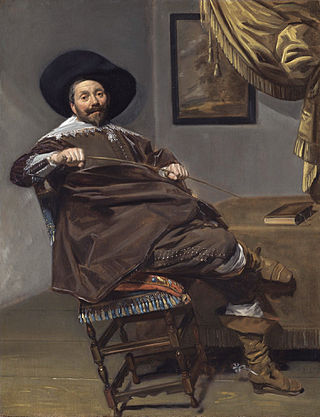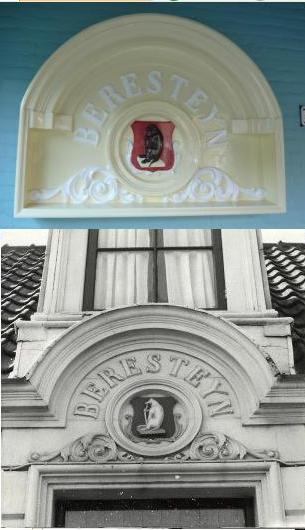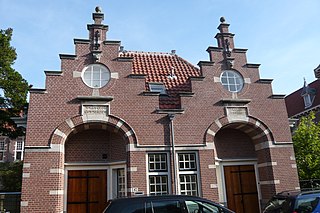
Frans Hals the Elder was a Dutch Golden Age painter, chiefly of individual and group portraits and of tronies, who lived and worked in Haarlem.

Haarlem is one of the cities in the Netherlands that has a number of hofjes. Some of them are still in use with boards of regents. Many of these are members of the Stichting Haarlemse Hofjes. The word 'hofje' just means small garden, because the hofjes are generally small houses grouped around a community kitchen garden with a water pump. Often they were attached to a larger field for bleaching linen or growing orchards, but today those fields have been long used for city expansion and only the central gardens can still be seen.

The Hofje van Willem Heythuijsen is a hofje in Haarlem, Netherlands. It was founded in 1650 by the testament of Willem van Heythuysen on the site of his summer residence outside the city walls of Haarlem on land that was considered Heemstede property until it was annexed in 1927. It is one of the few hofjes of Haarlem to be built outside the city walls. It has a 'T' shape and has a small open courtyard and a garden still intact.

Pieter Teyler van der Hulst was a wealthy Dutch Mennonite merchant and banker, who died childless, leaving a legacy of two million florins to the pursuit of religion, arts and science in his hometown, that led to the formation of Teyler's Museum. This was not the value of his entire estate. He also founded Teylers Hofje in his name, and made important donations to individuals in the Mennonite community.

The Vrouwe- en Antonie Gasthuis is a hofje on the Klein Heiligland 64a in Haarlem, Netherlands. It is open on weekdays from 10-17.00.

Willem van Heythuysen, was a Dutch cloth merchant and hofje founder in Haarlem and Weert. He is best known today for his portraits by Frans Hals, though he is remembered locally for his Hofje van Willem Heythuijsen bordering Haarlemmerhout park, which has been in operation for centuries.

The Proveniershuis is a hofje and former schutterij on the Grote Houtstraat in Haarlem, Netherlands.

The Hofje van Codde en Beresteyn is a hofje in Haarlem, Netherlands. The current building is from 1968 and is located on the J. Cuyperstraat, which is named for the architect who designed the Cathedral of Saint Bavo next door, Joseph Cuypers. This hofje is the wealthiest hofje foundation in Haarlem with the most modern facilities for its inhabitants. Poor (devote) Catholic women of Haarlem 60 years and older are still welcome to live there for free.

Wybrand Hendriks was a Dutch painter, primarily known for his portraits, and the concierge of the Teylers Museum.

The Coen Cuserhof is a former orphanage in Haarlem. The complex was designed by J.A.G. van der Steur and the original maquette is on display in the Historisch Museum Haarlem.

Gerrit Willem van Oosten de Bruyn, was an 18th-century lawyer from the Northern Netherlands.

The St. Elisabeth Gasthuis (EG) is a former hospital complex of buildings founded in 1581 in Haarlem on the Gasthuisvest. The last location of the hospital on the Boerhaavelaan retains its hospital function and is part of the Spaarne Gasthuis (SG) today, formerly known as Kennemer Gasthuis (KG). The hospital complex on the Gasthuisvest was built for the "Minnebroers" monastery and was reclaimed after the Protestant reformation in 1581 and given by the city council to the hospital. As a hospital during four centuries, the complex underwent many major renovations. The main facade dates from 1871.

The Banquet of the Officers of the St George Militia Company in 1616 refers to the first of several large schutterstukken painted by the Dutch painter Frans Hals for the St. George civic guard of Haarlem, and today is considered one of the main attractions of the Frans Hals Museum, Haarlem.

Joseph Coymans, was a Dutch businessman in Haarlem, known best today for his portrait painted by Frans Hals, and its pendant, Portrait of Dorothea Berck. The former resides at the Wadsworth Atheneum in Hartford, the latter at the Baltimore Museum of Art. A portrait of the couple's son Willem is held by the National Gallery of Art in Washington, D.C.

The Banquet of the Officers of the St George Militia Company is an oil-on-canvas painting by the Dutch artist Frans Hals, painted from 1626 - 1627, during the Dutch Golden Age. Today, the piece is considered one of the main attractions of the Frans Hals Museum.

The Officers of the St George Militia Company in 1639 refers to the last and largest schuttersstuk painted by Frans Hals for the St. George civic guard of Haarlem, and today is considered one of the main attractions of the Frans Hals Museum in Haarlem.

Michiel de Wael, was a Dutch brewer and citizen of Haarlem, best known today for his portraits painted by Frans Hals. His grandfather, also a brewer, was one of the first Calvinists in the city and was involved in the Siege of Haarlem.

Gijsbert Claesz van Campen, was a Dutch cloth merchant of Haarlem who is most famous today for his family portrait painted by Frans Hals. The sitters in this painting have been identified by Pieter Biesboer as the family of Gijsbert Claesz. van Campen and is today split into three parts; the left half is in the collection of the Toledo Museum of Art, with an extra baby lower left added by Salomon de Bray in 1628, the center half is in the collection of the Royal Museums of Fine Arts of Belgium, Brussels, and a third fragment on the far right from a European private collection make up the three known surviving pieces of the original portrait. These three segments were reunited at the Toledo Museum of Art for an exhibition October 18, 2018 – January 6, 2019. The exhibition traveled to the RMFAB in Brussels from February 2 – April 28, 2019 and the Collection Frits Lugt in Paris, from June 8 – August 25, 2019.

Claes Duyst van Voorhout is an oil-on-canvas portrait painting by the Dutch Golden Age painter Frans Hals, painted in 1638 and now in the Metropolitan Museum of Art, New York City.

Catharina Both van der Eem is a painting by the Dutch Golden Age painter Frans Hals, painted in 1620 and now in Louvre Museum. It is considered a pendant portrait to the Portrait of Paulus van Beresteyn, in the same museum.





























